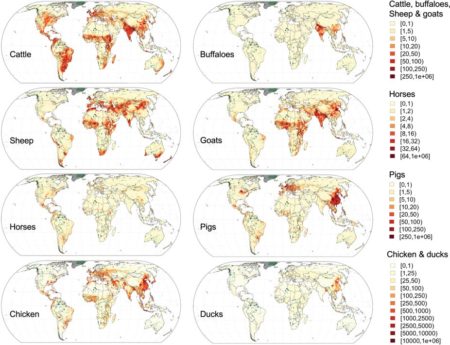A thoughtful Twitter threat about grazing.
Brainfood: Climate resilient crops, Food system limits, Phenotyping double, Sweet sorghum, Melon history, Paying4data, Beercalypse, Village chickens, Breeding 4.0, European maize, Brachiaria ROI
- Are agricultural researchers working on the right crops to enable food and nutrition security under future climates? No. Well, kinda.
- Options for keeping the food system within environmental limits. You need to pursue several. Including those discussed above, presumably.
- Deep Learning for Plant Stress Phenotyping: Trends and Future Perspectives. 3D CNN architectures applied to hyperspectral imaging is the future, apparently.
- Dealing with multi‐source and multi‐scale information in plant phenomics: the ontology‐driven Phenotyping Hybrid Information System. You’re going to need a fancy system to keep track to the data from the above.
- Sweet Sorghum Originated through Selection of Dry, a Plant-specific NAC Transcription Factor Gene. Could be applied to other cereals?
- Repeated domestication of melon (Cucumis melo) in Africa and Asia and a new close relative from India. Once was not enough.
- Paying for Digital Information: Assessing Farmers Willingness to Pay for a Digital Agriculture and Nutrition Service in Ghana. Cheaper is better. There’s a shocker. Oh, and women are more careful with their money.
- Decreases in global beer supply due to extreme drought and heat. 32% decrease in consumption in Argentina, 193% increase in price in Ireland. But clearly the authors have never heard of sorghum beer.
- The role of local adaptation in sustainable production of village chickens. Location, location, location.
- On the Road to Breeding 4.0: Unraveling the Good, the Bad, and the Boring of Crop Quantitative Genomics. Beyond breeding on predicted phenotypes, it’s sort of breeding for predicted environments.
- Maize yields over Europe may increase in spite of climate change, with an appropriate use of the genetic variability of flowering time. You don’t even need Breeding 1.0, if you deploy existing diversity optimally.
- Got forages? Understanding potential returns on investment in Brachiaria spp. for dairy producers in Eastern Africa. Definitely worth a flutter.
Brainfood: Emmer & drought, European legumes, Sainfoin, Alpine nomads, American domestication, Cereal domestication, Tree plantations, Garlic breeding, African veggies, African staple breeding, Sugarcane genome
- Genetic contribution of emmer wheat (Triticum dicoccon Schrank) to heat tolerance of bread wheat. It’s considerable.
- Warm Season Grain Legume Landraces from the South of Europe for Germplasm Conservation and Genetic Improvement. Ok ex situ, in situ not so much.
- Onobrychis viciifolia; a comprehensive literature review of its history, etymology, taxonomy, genetics, agronomy and botany. The fall and rise of an orphan forage.
- Interstitial but Resilient: Nomadic Shepherds in Piedmont (Northwest Italy) Amidst Spatial and Social Marginalization. Truly a vale of tears.
- Parallel vs. Convergent Evolution in Domestication and Diversification of Crops in the Americas. Still can’t tell which is more prevalent.
- Whole-Genome Analysis of Candidate genes Associated with Seed Size and Weight in Sorghum bicolor Reveals Signatures of Artificial Selection and Insights into Parallel Domestication in Cereal Crops. 63 seed size genes selected during domestication in sorghum, a significant number of which in maize and rice also.
- A systematic review of the socio-economic impacts of large-scale tree plantations, worldwide. Not a good idea.
- Recent Advances in Sexual Propagation and Breeding of Garlic. Restoration of flowering ability has done wonders for diversity. With diversity poster goodness.
- Core collection of two important indigenous vegetables; Gboma eggplant (Solanum macrocarpon L.) and Jute mallow (Corchorus olitorius L.) in Africa: An important step for exploitation of existing germplasm and development of improved cultivars. Interesting, of course, but I wouldn’t call these core collections. But I won’t complain again if it gets the stuff used more.
- Measuring the impact of plant breeding on sub-Saharan African staple crops. High ROI for the usual suspects. How about the traditional veggies et al., though. Anyway, do readers want more on this paper? Let me know in the comments if you want a full post on the main findings.
- Allele-defined genome of the autopolyploid sugarcane Saccharum spontaneum L. A lot of the good stuff is in wild-cultivated rearranged chromosomes.
Counting your chickens
A new version is out of the FAO global livestock density datasets, which we have blogged about before. This is the third iteration (GLW3), and it has a reference year of 2010. There’s a paper to give you all the details. 1

But there’s more to come:
Future versions of GLW will differentiate stocks according to production systems for ruminant (meat vs. dairy) and monogastric species (intensive vs. extensive, meat vs. egg production). Higher resolution models 2 for individual countries where the census data can support such predictions will also be produced.
The datasets are also available for download from Harvard Dataverse.
Nibbles: ITPGRFA, CIMMYT, VIR, Livestock & CC, Vesuvius, Apple pie, Biobanking
- The Plant Treaty tries to enhance itself: the story so far.
- CIMMYT gets a podcast. Here’s one on blue maize.
- The Vavilov collection put to good use. Again.
- “Cow farts cause more climate change than cars.” Not really. Here comes the science, by way of a Twitter thread, of all things.
- The Pompeii eruption: August, or October? Here comes the archaeobotany, among other things, by way of a Twitter thread, of all things.
- It was World Apple Day or somesuch, so here’s two canonical feel-good heirloom apple stories.
- Fancy an open-access special issue of Biopreservation and Biobanking? Too nerdy? It’s on agricultural genebanks… Yeah, I thought you might.